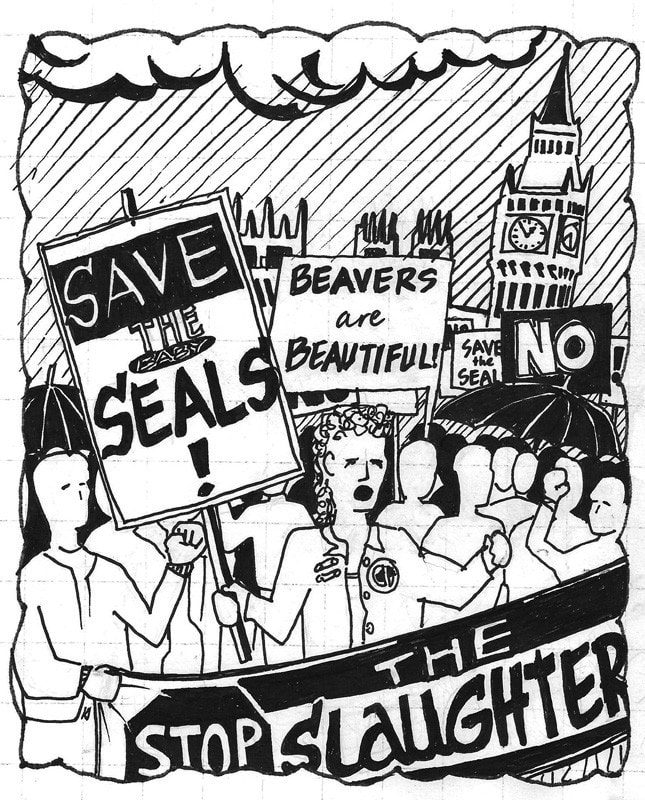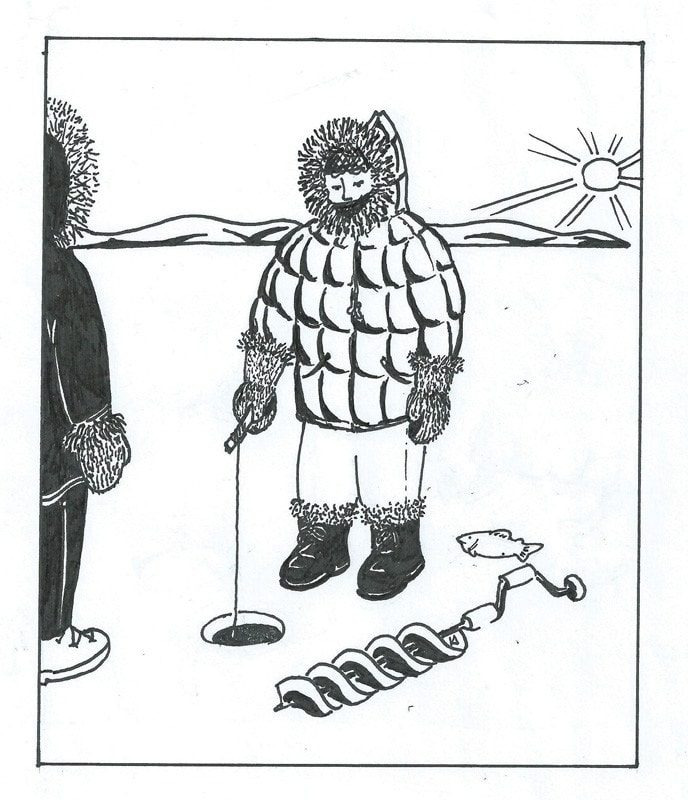
An Animal Rights Activist’s Change of Heart
by Ruth Bowen | illustrations by Kris Schlagintweit
Brian frowned at my down parka. Bought for $50 in an English discount store, I doubted it would be up to the rigours of a Yellowknife winter but, amazingly, it got the thumbs-up. “Except this…” he touched the fur around the hood. “Nylon. Worse than useless. You need the real thing.” Brian had recently moved to Ontario after 30 years in Yellowknife and knew my one Canadian friend, who introduced us in a rooftop lounge in Toronto. It was January 2010, my first full day on Canadian soil. In a few days I’d be going north, but meantime I was sweltering and self-conscious amid the chrome and glass. I nodded politely, knowing I was a total rookie to the cold, but also sure I would never take Brian’s advice.
At school in the English Midlands, my friends and I had wept and raged at images of baby seals being clubbed then skinned alive. Just out of university, I moved to London in the late 1970s at around the time the Greenpeace anti-sealing campaign began to take off. Although I hadn’t gone on any marches in a long time, I wasn’t going to wear real fur, a superfluous, luxury symbol of ostentatiously excessive wealth.
The first time I went out in -35 C, my face was ringed by ice within minutes and I couldn’t see through my frozen specs. My second week in Yellowknife, I found a battered jacket at St. Pat’s flea market with a thick strip of coyote – yes, real fur – around the hood. I justified it to myself on the grounds of (a) necessity and (b) the coyote had probably had a life, not been bashed to death as a newborn at the flippers of its frantic mother. I spent an afternoon bloodying my fingers sewing the ruff to my parka with a poker-thick needle designed for stitching boat sails.
Three years later, I’m back in Yellowknife for the sixth time, hopefully for good. Weirdly to many, I love the winters here: I love the stark whiteness, the absolute silence, the way the air scrubs my nostrils and clears my head, the sense of life stripped to its elemental basics. But loving the cold doesn’t mean loving being cold, and I’ve struggled with clothing my hands, especially to retain some dexterity. I’ve yet to find a pair of winter working gloves that don’t flop empty from the ends of my stubby fingers, and various mittens haven’t worked either, even with thin gloves. And there’s the cuff dilemma – do you wrestle sleeve-over-glove, or glove-over-sleeve?
Then I saw a mitten-making workshop advertised. There was a choice of designs, AND I could tailor them to my size AND I didn’t need to know how to sew. Perfect! I just had to pay the money and turn up at Northern Images with my lunch and materials. Hmmm. Materials. Just what would they be? I needed something practical for working and playing outdoors, going ice fishing for example. Primarily, the mitts must be warm. Second, they had to resist water. They also needed some grip and toughness. It all pointed to a leather or fur outer, with a fur or wool lining. Fur.
Since coming North, I’ve had so many of my assumptions and prejudices challenged and confounded. The parka hood was just the start. My disdain for hunting, based on it being an upper-class sport for the British, was turned on its head when I began to learn about the spiritual, as well as cultural and nutritional importance of the traditional caribou hunt; how the entire animal is utilised, and respected, including in death. Brian had told me his warmest outfit was a suit of uncured caribou skin. “Smells a bit by the end of winter, but you make another the next season.”
Last year, before returning to England, I went shopping for gifts. “You can’t take that,” I was told, as I fingered a miniature pair of mukluks. “It’s sealskin. Banned in Europe.” Made in the High Arctic, this exquisite work probably fell into the tiny proportion of skins that, according to the EU regulation, come “… from hunts traditionally conducted by Inuit and other indigenous communities which contribute to their subsistence.” These are exempt from the ban, but only on compliance with labyrinthine monitoring, checking and regulations. And there is no chance of that happening for Canadian skins anytime soon, if ever, because Canada is actively disputing the legality of the 2009 European legislation. Another hammering for traditional communities. Historically, this started with the traders who lured them from a subsistence culture into selling pelts, creating an economic dependence and vulnerability to market vagaries and fickle fashion, forever changing a way of life.
I had already succumbed to coyote, had spent a night in a quinzhee on caribou fur, and now my anti-seal stance seemed shaky too. So it wasn’t such a big step to go to the Native Women’s Association, to look through the pelts they sell, all harvested in the North. They were – are – beautiful; the sealskin luminescent, the sheared beaver so soft I longed for 40 below, just for the excuse to wear it.
Charissa Alain-Lily’s workshop obliterated all memories of ghastly school needlework classes, forced to make stupid frilly things I’d never wear. Although she offers several styles, none were quite what I had in mind, so she helped me adapt her standard boxer mitt by extending the cuff, gauntlet style. Based on an Inuit design, the boxer follows the natural curve of the fist, allowing a more accurate grip. Contrary to my expectations, and previous efforts to stitch leather, she taught us to use the smallest needle possible: the glover has a three-sided point, making it sharp enough to glide through hide most of the time (and very painful, as she had warned, when I stabbed myself). For eight hours I barely moved from my seat, and even had to be reminded to eat lunch.
I didn’t, in the end, use fur. I’m making my mitts from an old leather coat, lining them with off-cuts from a felted tablecloth. I’m not famous for neatness or accuracy and decided my first pair should be practice. I’m still hacking and jabbing away, but I’m learning, before moving on to the real thing: sealskin. With the endless summer light, I have all night to wield glover and scissors and by winter will be ready to grip that fishing line with furry hands.








